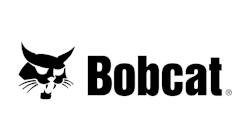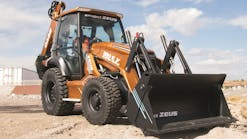There is no complete substitute for real world experience, but simulators provide multiple advantages to field training. The simulator modules provide mockups of actual operators’ cabs. They provide not just the “look” of the operator’s environment, but the “feel” as well via mechanical and physical feedback to the training through the levers and pedals they use to operate the simulation. This physical feedback gives the trainee “muscle memory” of the tasks needed to run the equipment. The trainee’s movements and controls become instinctual.
Once this muscle memory is established, actual field training becomes much easier and faster. As a result, the time required for actual machine training is considerably reduced. This results in a significant cost savings in fuel, wear-and-tear, and other machine operational costs.
A Simlog Hydraulic Excavator Personal Simulato
Simulators also provide an aptitude screening mechanism. At little cost and without any potential safety issues, those operators that are not competent enough to operate an earthmoving machine safely and effectively can be weeded out of the training program. This may sound harsh, but remember that these machines are potentially dangerous and always expensive to operate. No contractor can afford a work site accident (and potential lawsuits) or cost over runs resulting from inefficient operation. Only those trainees with the potential to be effective machine operators should be allowed to pass the simulator training.
Additionally, simulator training can instill good operating habits and a safety awareness in a controlled environment. Unlike field training, which has to be supervised, simulator training can be self directed without the need for an instructor providing direct supervision.
Inside Hawkeye Community College’s Simulation Trailer
Typically, several simulators are set up in a single large room. The central server that runs them is often referred to as the “Simulation Manager.” This server provide the data and graphics for training, instruction to the trainee on tasks that will comprise their final skill set, and keeps a record database of each trainee’s performance and progress through the training regime. In doing so, each trainee becomes familiar with the equipment and its limitation. Constant drilling in the basic machine tasks builds operator proficiency. Building on basic skills, the trainee can advance to more complicated tasks with each stage providing scenarios of real-world situations and operations.
Testing, both in question format and via the assignment of simulated tasks, evaluates the inherent skill and aptitude of the trainee. With each lesson and instruction module, the simulator’s software records the information to a database that summarizes how safely, effectively, and efficiently the tasks are performed. The evaluation metrics include cycle time (the amount of time needed to complete a single task), loading and excavation accuracy, safety infraction involving other simulated equipment and pedestrians, etc. Each category delineates where a trainee needs to improve and when he can go on to the next level of instruction.
Companies like CM Labs have been investigating “cutting-edge,” new technology for hand, head, and body tracking together with “cave” environments. Currently, this technology is not very robust and will take time before it can be used daily in the classroom. However, simulators are becoming even more immersive, the costs continue to come down, and the fidelity continues to increase. Head-mounted VR sets are also available, but there are issues with this technology for operator training. You cannot see the controls around you (you are totally immersed), and there are still a lot of issues with fatigue and motion sickness when wearing the displays for a long period of time. VR headsets will have a place in operator training, but they also cut off the trainee from the physical machine and the learning environment.
Major Simulator Suppliers
Caterpillar Inc. currently offers 12 simulator models in its product line. Cat Simulators are developed and manufactured by Simformotion LLC, the licensee for Cat Simulators for Caterpillar. The simulators feature actual Cat controls on the hardware. The controls, buttons, switches, and pedals are unique to each machine being simulated in order to most closely match the actual piece of equipment. This allows operators to train in the virtual environment and move quickly to the actual work site using the techniques they learned on the simulator. Some systems use both a front and back monitor to better convey the operator experience.
The newest simulator system, the Large Wheel Loader, features a three-monitor configuration that increases an operator’s visibility in all directions. All systems are also equipped with a Machine Walkaround exercise. This is the same pre-inspection Walkaround that is required before beginning any shift. The Walkaround generates random fault points, which the operator must identify. The exercise teaches the operator what to look for and whether the machine is in ready-condition to be used on a shift. Some systems are also equipped with a motion platform that allows users to experience forward/backward and left/right tilt, as well as up/down movement and vibration when the simulated machine is running. The software has been developed by their programming team in close coordination with motion specialists to provide very specific information to the motion platform. In turn, the simulated machine’s physics respond/react realistically to the environment, maneuvers, and terrain.
Cat Simulators are used at schools, training institutions, large construction companies, mining operations, government entities such as the DOD or DOT, and other organizations teaching heavy equipment training. The Aecon Mining Company is one such example. Aecon began using simulators in its program four years ago.
“At that time, we were hiring a lot of new haul truck drivers and needed a way to prove they were proficient. We were hiring experienced workers and putting them to work only to find out they were not qualified,” says Danny Turner, the Training and Development Coordinator at Aecon Mining in Alberta, Canada. “Before the simulators, we put the operator on the equipment through various exercises to see if they fit what we require for a particular job with their skill set [a finished or inexperienced operator]—this used to take up many man hours.”
Simulator training allows for a variety of scenarios in a simulated environment, before having to go into the field. “We would much rather have a mishap on a simulator than on actual equipment, thereby preventing any potential accidents and ensuring the safety of our team,” adds Turner.
Open Training helps operators develop and perfect the motor skills needed to operate the equipment. “The addition of the motion system on the simulators brings an even more lifelike feeling to the experience,” he says. “Some of our experienced excavator operators could not pass the simulator benchmarks at first, until we showed them what they were doing wrong [overloading the bucket, not setting up right, and overloading trucks]. After simulator training, the operators did a great job saving wear-and-tear on the equipment. They took what they learned back into the field.”
Each simulator (sold by Simformotion’s in-house sales team both through the Caterpillar dealer network and directly to customers) features simulation software with unique training exercises that cover applications specific to the machine being simulated. More than 100 interactive training exercises have been developed for Cat Simulators. Many of the simulator systems also come with an eBook on an iPad that explains the purpose of each exercise, sets the expectations for operator performance, shows how-to images and video samples of the proper way to conduct the exercise, teaches safety, offers operator tips, and more. Cat Simulators also offer the capability to track and keep records of the operator’s performance. The simulators track hundreds of metrics, including time, usage, speed, amount of material moved, and overall productivity. Reports are generated that can be used to track performance throughout training.
John Deere Construction has equipment simulators with motion capabilities that simulate the terrain the equipment is traversing. In addition to their customers, dealers, high schools, community colleges, and the international union of operating engineers use the simulators for their training programs. At the high schools and community colleges, programs are designed to train the next generation of operators for careers in the construction industry.
Celeste Turner, Regional Transportation Training Center (RTTC) Coordinator, says, “Hawkeye Community College is scheduled to take simulators around to area High Schools to introduce students to a career without having to receive four-year degree. By putting our students in the simulators we create an in-cab environment that is safe, risk-free, and unintimidating while student gets a feel of the real machines. It helps to settle some nerves of anxious students.”
John Deere has a three level blended approach to operator training: Level 1: self-study materials, Level 2: simulators, and Level 3: hands-on machine time.
Level 1 offers a variety of DVD videos and multimedia resources that teach the basics of safety, maintenance, and operation. Both beginners and experienced operators benefit from training in daily service checks and all the controls in the cab, so when a new piece of equipment is dropped off, they can come up to speed quickly on the new features. Tips from the courses teach newcomers how to work efficiently on the job site. Experienced, skilled operators give their best inside tips on how to work safely while using machine features to their advantage. These courses (available on DVDs and online) are a great resource for a new operator looking to save time on the job and increase their overall productivity.
Level 2 is focused on getting new operators in the seat through the use of John Deere simulators. Through the use of highly detailed and realistic lessons, operators learn proper operator technique, machine controls, and safe operation in a virtual job site.
Level 3 consists of hands-on training with the model(s) of equipment desired and an instructor present, typically supported by a John Deere dealer.
In addition to direct training, the videos, software, and simulators are indirectly valuable as sales and marketing tools. Many John Deere dealers have the simulators in their fleet, including a pull-behind trailer so they can take them to customer job sites or other local tradeshows.
At a recent event sponsored by IowaWorks, Hawkeye community college pulled a large semi-trailer full of John Deere simulators across the state of Iowa to encourage woman to go into the construction field. According to them:
Davenport, IA: This week people can experience what it’s like to be in the driver’s seat of a heavy-duty excavator, forklift, and other construction equipment. . . . The heavy equipment simulator allows people to learn what it’s like to use the controls of equipment such as a backhoe, dump truck, welder, excavator, and forklift. . . . The simulator is touring the state thanks to a Walmart Foundation Grant awarded to Iowa Workforce Development, IowaWORKS, and Hawkeye Community College. Locally, Eastern Iowa Community Colleges is assisting in the project. The focus of the grant is to introduce women and minorities to careers in these construction fields. The simulators, however, are open to everyone and anyone who wants to give them a try.
Founded in 1999, Simlog is a pioneer in the use of simulation for heavy equipment utilizing off the shelf PCs. Through the unique option of having a portable tabletop or operator chair setup, multi-display configurations, and the use of USB-ready, industrial strength, Replica Controls, Simlog offers customers a wide range of options to cater to everyone’s needs, and just using one off-the-shelf PC.
This approach has created cost effective simulation technology and industry awards for innovation. Simlog’s 13 Personal Simulators (15 soon, with Backhoe Loader and Motor Grader currently under development) have an instructional design focused on developing core skills of increasing difficulty. It helps customers provide pre-employment skills “assessment,” pre-screen operators for “aptitude,” prepare new operators for real seat-time, cross-train, “reveal” operator weaknesses and bad habits, and assist operators with “refreshing” skills. All users’ training results are automatically saved into a database, reducing costs, machine downtime, and time spent monitoring candidates one-on-one.
And even while using extensive simulator training, Simlog understands that it is no substitute for hands-on training. Simulated training is a tool to help people develop their skills in a safe environment that can be repeated over and over again, so when they do graduate to learning on a real machine, they can be safer, more productive operators, avoiding potentially dangerous, and always expensive, field training.
“By making simulator time a key part of our program, we can prepare students in the classroom with practical experience that transfers to machine operation in the field,” says Janet Sortor, Southern Maine Community College, a Simlog Customer. “We are making training safer and less costly by limiting machine time and wear and tear on the contractor’s equipment, not to mention the $50,000 annual fuel costs.”
ThoroughTec Simulation is a South African company with an extensive background in advanced military simulation and over two decades of experience designing and producing workforce optimization systems for heavy equipment operators in the mining and construction sectors. Their range of CYBERQUIP Construction Equipment Simulators are designed to cost-effectively train and evaluate operators of all levels, in the safe and efficient operation of all types of construction equipment, ranging from graders to excavators, and everything in between.
CYBERQUIP evolved from the company’s highly successful CYBERMINE range of high-fidelity systems and can simulate earth-moving equipment from all major manufacturers such as Bell, CASE Construction, CAT, Hitachi, JCB, John Deere, Komatsu, Liebherr, New Holland, Terex, and Volvo. The main differences between the two lie in the capabilities of their respective “base units” and complexity of the training scenarios covered by the systems. CYBERQUIP and CYBERMINE simulators have been delivered to the following institutions: Anglo Coal Training Centre in Mpumalanga, South Africa; Aurora College in Yellowknife, Canada; BDTBT Training Centre in Indonesia; Curtin University in Perth, Australia; NORCAT in Sudbury, Canada; Services SETA in Johannesburg, South Africa; University of Alaska in the USA; University of Santo Tomas in Iquique, Chile; Yukon Mine Training Association in Whitehorse, Canada. They have developed over 40 dozer, grader, excavator, and shovel simulators so far, for use in the mining and construction sectors.
High-fidelity Full Mission Simulator (FMS) systems allow for precise training in a safe and controlled environment and concentration on specific tasks. This is done while being continuously monitored and corrected, and trainee operators receive accelerated training that ensures retention of critical knowledge and development of skills in a predictable and repeatable fashion. Usually it’s common for novice operators to go through several weeks of simulator training until they are competent enough to complete their training on the actual equipment. Simulators are able to bridge the gap from classroom to hot-seat training faster by combining visual cues, motion, sound, and motor memory with an advanced reporting system to fast-track mining students to the required competency level.
CYBERMINE’s simulated view
During training, operator errors are identified and recorded so trainees are able to focus in on problem areas, without wasting time on the aspects they have already mastered. Experienced operators are usually expected to recertify on the simulator every few months. Simulators are consistent and impartial; they understand the optimal methods to be employed and the performance standards to be achieved. There is simply no fooling them. In this way, even seasoned operators are forced to face their complacency and bad habits, before they become a problem onsite.
Vortex Simulators by CM Labs provide training exercises that familiarize novices with the equipment they’re using, starting at a very basic level, and then progressing through the skills curriculum up to advanced operations. Companies use their simulators not just to train, but also to pre-screen novices to see if they have the aptitude for using the equipment, while others use them for actual employment pre-screening and for refresher courses for experienced operators. This feedback is two-way, with Vortex Simulators also being used for operator assessment in order to calibrate training program requirements and evaluate who is the best operator for a complex job. The training is used for both the completion of operator certification, and also as a sole requirement for recertification.
In addition to individual training, Vortex simulators also teach teamwork. Traditionally, it has not been possible to really teach teamwork in the classroom, but with simulation this can be done. Crane operators and signalmen can work together in a simulated learning exercise; an excavator operator can work in a busy work site and even with other simulated machines working around them at the same time; all in a multi-simulator collaborative environment.
Their heavy equipment industry client profiles include contractors (NCSG, Kiewit) and training schools/community colleges (SAIT, Keyano College, CIA, CSI, CIS), as well as operator unions (IUOE), major utilities (Alabama Power, Bruce Power, Palo Verde Nuclear), and railroads (BNSF, CN). Large OEMs are also using their simulation software “under the hood” of the simulators they already use to train their clients and users (Liebherr, Mammoet, and Manitowoc).
Working with integrators and equipment manufacturers D-Box has partnered with CM Labs, John Deere, Simformotion, Caterpillar, Tenstar, and others to develop a system of kinesthetic cues (what an operator’s body feels in a simulator) in a large variety of deployed simulators. Their Motion Cueing Systems make for a more realistic sensory experience and are included in simulators to allow operators to train more efficiently. Since most operators are multimodal trainees they learn better when they see, hear, and feel. Because of this, motion cueing technology is an essential component of the trainee experience. Motion generates kinesthetic cues and stimulates the muscle memory.
And as operators spend more time training virtually, this process builds better operators—ensuring more efficient and safer operations. By integrating with simulation training software, D-BOX motion technology gives operators a visceral experience of operating heavy machinery under all conditions. The use of precise kinesthetic cues help operators develop accurate psychomotor reflexes and improves safety awareness in the field. Earth-moving simulation scale is extremely large. It goes from the E-Learning set of slides on a Web browser to very high-end systems reproducing the behaviors of a machine to stimulate all operators senses. D-BOX motion cueing systems allow the most advanced types of simulators to bring back motion feelings to operators. In addition to being used as a marketing tool and as branding promotion equipment, D-BOX enabled simulators are used in many training centers by contractors either to train new operators, or to keep their skill up to date for experienced users.











